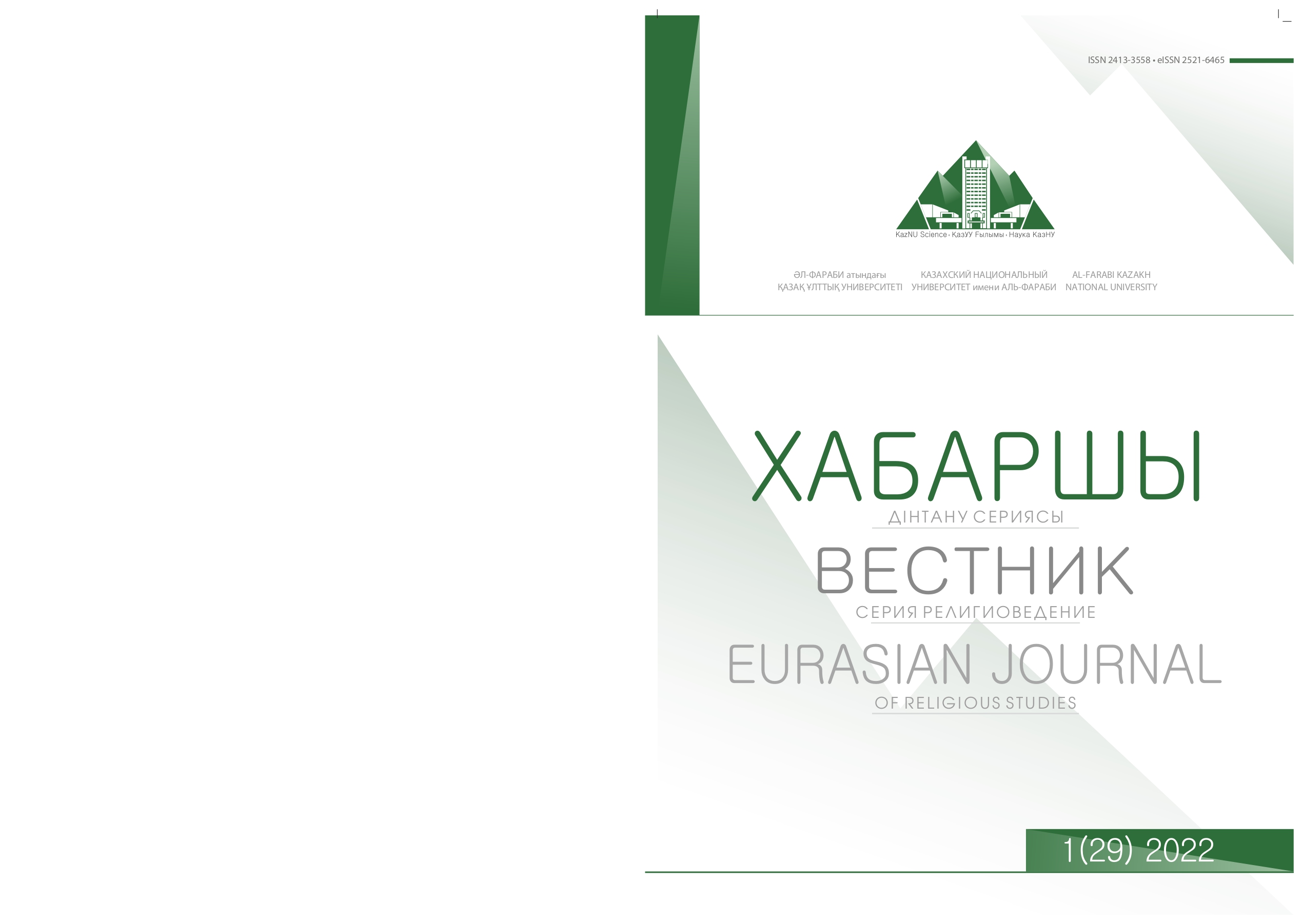Паломничество индусов в Тибет и его влияние на китайско-индийские отношения
DOI:
https://doi.org/10.26577//EJRS.2022.v29.i1.r10Ключевые слова:
Индусы, Тибетский автономный район, Трансграничное паломничество, Китайско-Индийские отношения, Пограничные конфликтыАннотация
В эпоху глобализации религия, несомненно, играет особую роль в отношениях между народами. Трансграничные паломничества, как важная практика верующих, также являются инструментом развития двусторонних связей и способствует обогащению религиозного опыта паломников. Непрерывное расширение трансграничных паломничеств имеет эффект, который нельзя игнорировать в двусторонних отношениях и будет способствовать дальнейшему развитию и других видов сотрудничества, взаимообмена между двумя этими странами, решению различных приграничных проблем при их возникновении. Исходя из этого, в данной статье анализируется паломничество индусов в китайский Тибет с точки зрения международных отношений, рассматривается влияние трансграничных паломничеств на китайско-индийские отношения с разных точек зрения и взаимные ограничения между государственными отношения, так же анализируется религиозные паломничества на приграничье конкретно на примере инцидента Доклам. На основе данного анализа делается вывод, что при условии активного стимулирования Китаем и Индией положительного эффекта трансграничных паломничеств и повышения консенсуса и взаимного доверия между правительствами и народами при урегулировании пограничных конфликтов, отношения между двумя странами будут развиваться в определенной степени гармонично.
Ключевые слова: Индусы, Тибетский автономный район, Трансграничное паломничество, Китайско-Индийские отношения, Пограничные конфликты
Библиографические ссылки
“China Agrees to Let Mansarovar Yatra via Nathu La Pass” (2018) News Bharati, February 9. https://www. newsbharati.com/Encyc/2018/2/9/Mansarovar-Yatra-via-Nathu-La-Pass.html
“China Plans International Airport in Tibet; to Facilitate Mansarovar Visit” (2019). - Press Trust of India, April 2. https://www.business-standard.com/article/pti-stories/china-plans-to-upgrade-an-airport-in-tibet-to-int-l-status-to-facilitate-mansarovar-yatra-pilgrims-119040200812_1.html
“Chinese and Indian Foreign Ministers Concluded Talks” (1981) People’ Daily, June 29.
“Documents of the Agreement between the Republic of India and the People’s Republic of China on Trade and Intercourse between Tibet Region of China and India” (1954) Archives of the Ministry of Foreign Affairs of China, June 3. – 13-15.
“Eye on China, India Pushes More Troops in Doka La in Longest Impasse Since 1962” (2017) Defense News, July 2. http://defensenews-alert.blogspot.com/2017/07/eye-on-china-india-pushes-more-troops.html
“Indian Pilgrimages to Tibet Successfully Achieved” (2015) Xinhua Net, March 7. http://www.xinhuanet.com// politics/2015lh/2015-03/06/c_1114553224.htm
“Kumbh Mela ‘Shravan Shudha- First Snan’: Thousands of Devotees Take Dip on the Banks of Godavari River” (2015) – The India Express, June 5. https://indianexpress.com/photos/picture-gallery-others/kumbh-mela-shravan-shudha-first-snan-thousand-of-devotees-take-dip-on-the-banks-of-godavari-river/
“Spokesperson for Chinese Embassy in India Made a Speech on Indian Pilgrims” (2017) Xinhua Net, July 6. http:// in.china-embassy.org/chn/sgxw/t1475809.htm
“The Agreement between the Republic of India and the People’s Republic of China on Trade and Intercourse between Tibet Region of China and India” (1954) People’s Daily, April 30.
“The Changing Global Religious Landscape” (2017) Pew Research Center, April 5. – 8-10.
Chaudhury, D. (2018) “Kailash Mansarovar Yatra through both Nathula, Lipulekh Pass Routes Opened after Sino-Indian Understanding”, The Economic Times, February 22. https://m.economictimes.com/news/politics-and-nation/ kailash-mansarovar-yatra-through-both-nathu-la-lipulekh-pass-routes-opened-after-sino-indian-understanding/articleshow/63023464.cms
Gao, F., Peng, C., Lu, D. (2019) “ Analysis of Cross-Border Ethnic Groups and Peripheral Communication”. - Journalism Lover, Vol.3. – 14-17.
Gupta K. (1978) “Sino-India Agreement on Tibetan Trade and Intercourse: Its Origin and Significance”, Economic and Political Weekly, Vol. 13, No. 16, April 22. – 696-702.
Huntington, S. (1968) Political Order in Changing Societies. - New Haven and London, Yale University Press. - 154.
“Documents Signed between India and China during Prime Minister Vajpayee’s Visit to China” (2003) Indian Ministry of External Affairs, June 23. https://www.mea.gov.in/bilateraldocuments.htm?dtl/7692/Documents+s igned+between+India+and+China+during+Prime+Minister+Vajpayees+visit+to+China
Kulkarni, S. (2019) “High Road to India-China Partnership”. - China-India Dialogue, May 14. http://chinaindiadialo gue.com/high-road-to-india-china-partnership
Lin, G., Ye, Z. and Han H. (2001) Relations between Contemporary China and South Asian Countries. - Beijing: Social Sciences Academic Press. – 75-76.
Liu C., Ge Y. (2012) “Indian Ambassador to China Visits Tibet at the Invitation of China”. - People's Daily Online, July 3. http://world.people.com.cn/n/2012/0703/c1002-18430250.html
Liu, Z. (2017) “Religions and Diplomacies from the Perspective of Theoretical Changes in International Relations”, International Review, No.4. - 80.
Mankekar, D. (2003) The Guilty Man of 1962. - India: Penguin Books. - 138.
Mu, X. (2017) “China Says Nathula Pass’ Re-opening Depends on the Indian Side”. - Xinhua Net, June 29. http:// www.xinhuanet.com//english/2017-06/29/c_136402078.htm
Petito, F., Hatzopoulos, P., eds. (2003) Religion in International Relations: the Return from Exile. - London: Palgrave Macmillan.
PTI (2017) “Dialogue is the Only Way to Resolve Conflicts: PM Modi”. - Times of India, August 5. https://timesofindia.indiatimes.com/india/dialogue-is-the-only-way-to-resolve-conflicts-pm-modi/articleshow/59927855.cms
Qiu, Y. (2019) “Analysis on Sino-India Boundary Problems from Cultural Perspective”, South and Southeast Asian Studies, No.4, August. - 12.
Raman, B. (2003) “India-China: Countering the Spin”, Outlook India, June 30. https://www.outlookindia.com/web site/story/countering-the-spin/220590
Sail, M. (1998) India-China Border Dispute: A Case Study of the Eastern Sector. - Delhi: APH Publishing Corporation. - 102.
Srikanth, T. (2013) “An Analysis of India’s Hedging Strategy towards China”, Journal of Contemporary Asia-Pacific Studies, No.4. – 23-53.
Stephen Greenbaltt, Ines Zupanov, etc. (2010) Cultural Mobility: a Manifesto. - NY: Cambridge University Press. - 6.
Tan, H. (2020) “Reflections on the Overseas Religious Penetration in the New Era”, Journal of South China University of Technology (Social Science Edition), Vol.12, No.4. - 69.
The China-India Border 2 (1960). - Beijing: World Affairs Press. - 36.
Turner, V. (1970) The Forest of Symbols: Aspects of Ndembu Ritual, Ithaca. - NY: Cornell University Press.
Turner, V. (1973) “The Center out There: Pilgrim’s Goal”, History of Religions, Vol. 12, No. 3, February. – 191-192.
Wang, H. (1998) The Himalayas Sentiment: A Study of Sino-Indian Relations. - Beijing: China Tibetology Publishing House. – 84-94.
Xu, Y. (2010) “Religion and Contemporary International Relations”, International Studies, No.2. - 46.
Xu, Y. (2018) “Religion of Great Power”, Religion and American Society (Volume 16). - Beijing: Current Affairs Press. – 4-10.
Yang, Y. (2017) “Full Text of Facts and China's Position Concerning Indian Border Troops’ Crossing of China-India Boundary”. - Xinhua Net, August 2. http://www.xinhuanet.com//english/2017-08/02/c_136494625_7.htm
Ye, H (2020) “China-India Relations in Changing Situations”, Current Affairs Report, No.5. - 38.
Zhang, J. (2013) “Tibet Welcomes the First Official Indian Pilgrims in 2013”, The State Council Information Office of the People’s Republic of China, July 4. http://in.china-embassy.org/chn/zygx/zywl1/t1056229.htm
Zhao, E. (2019) “Burang and Yadong Ports in Tibet Welcome the First Batch of Official Pilgrims in 2019”, China Tibet Online, June 21. http://www.tibet.cn/cn/news/yc/201906/t20190621_6617090.html




